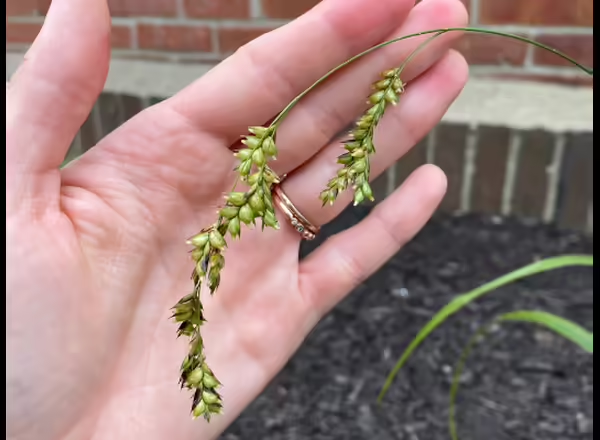
A year ago my family moved. As a gardener, I was looking for a house with a big yard with lots of potential to plant huge gardens. We found a home with almost a blank slate of a yard – after spending a few weeks removing invasive trees and shrubs we were ready to establish landscape beds and get planting!
Ok, that makes it sound easier than it was. It was a lot of work, but one year later I’m reflecting on the work we’ve done so far, and the changes I’m planning for next year.
My intention behind my gardens is to plant native plant species, to better hold soil in place and build up its health, to help pull water deep into the soil, rather than it running off to the storm drain, and to provide food and habitat for insects, birds, and other wildlife. And of course to be beautiful too!
While it’s easy to pick and choose all my favorite flowers to plant, I made sure to include a number of grasses (and a sedge) as well! What purpose do grasses serve? Probably more than you might think!
Role of grasses
Adding in grasses to a native planting can help increase root competition between the plants, which can help natives stay a bit shorter, rather than flopping over, as can be common in planted gardens. Their roots are much longer than the roots of lawn grasses. Some grasses are eaten by caterpillars or feeding insects like leafhoppers. I’ve also seen numerous insects and other critters (like skinks) hiding among the foliage.
What grasses have I added?
So far I have Prairie Dropseed, Little Bluestem, and Beakgrass. I also have Gray’s Sedge. I like to plant my grasses in clumps of 3. This fall I’ll likely add in Switchgrass, Side Oats Grama, Bottlebrush Grass, and several other species of sedges. While I thought I planted quite densely, some of my plants grew incredibly tall (my Prairie Blazing Stars topped out at 6 feet !) and did still flop from the height. I’m planning to add in a few more clumps of grasses to try to increase root competition and keep the other plants a bit shorter.
Right now all of my grasses are blooming or starting to bloom, which is always exciting. My Prairie Dropseed is putting out narrow branched panicles, while my Little Bluestem has started to bloom too. My Beakgrass spikelets have produced rounds seeds.
Fall is a great time to add native perennials to your garden. Will you consider adding some grasses?
Need a refresher on grass identification terms? Check out this blog post!



Thank you for reading!
Never miss a new post! Subscribe to our email list to get updates each time a new post is available.
Give us feedback! How helpful was this information (click one): Very helpful | Somewhat helpful | Not very helpful
ABOUT THE AUTHOR: Erin Garrett is a Natural Resources, Environment, and Energy Educator for University of Illinois Extension serving Alexander, Johnson, Massac, Pulaski, and Union counties. Erin develops and delivers high impact programming to adults and youth to help them develop an appreciation for natural resources and to empower them to make small changes to positively impact the environment. Erin’s programming focuses on why homeowners should consider choosing native plants, how to support native pollinators, how to identify grasses, how to identify and manage invasive species, and developing an appreciation for prairie ecosystems.